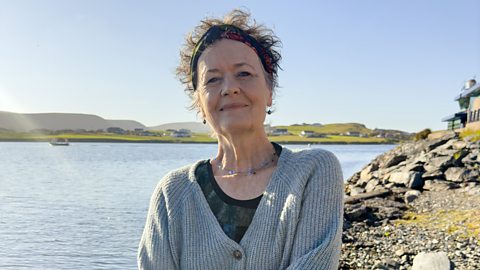Born: 1956
Nationality: British
Date of composition: 2011
Period: 21st Century
Genre: Concerto (folk inspired)
Key musical elements:
- Form / structure / meter

About Sally Beamish
- As well as being a famous composer of classical music, Sally is a viola player.
- She began her musical career performing with ensembles in London.
- Sally writes music for a wide variety of instruments and ensembles including music for opera, theatre, solo instruments with orchestra and traditional folk instruments.
- She is largely self-taught as a composer.
- Sally studied viola in Manchester.
About the piece
- Haven is the final movement from a concerto called Seavaigers (pronounced ‘SEE - vay – gers')
- Seavaigers means seafarers in Scots. Seafarers are people who travel by sea and work on boats
- Haven is about the long-awaited return to home after experiencing the rough seas and wild weather at sea
- The solo instruments in Seavaigers are the clársach (Scottish harp), and the Shetland fiddle. These are played by Catriona McKay and Chris Stout who are from Dundee and Shetland. These are places in Scotland whose history is heavily connected to the North Sea.
- In Seavaigers Sally Beamish brings together traditional folk instruments and a classical string orchestra to create a musical fusion of sound.
Listen out for
- The free, improvisatory style - which parts do you think were written down by the composer for the soloists and which parts do you think might be improvised by them?
- Pizzicato (plucked) playing at the start, and the effect of pizzicato versus bowed playing in the strings throughout.
- The use of staccato and accents in the strings to emphasise the sense of unity when playing same rhythms.
- Constantly changing time signatures (e.g. try and follow the double bass to hear where beat one of the bar lands, it changes bar to bar with the regularly changing time signatures)
Watch the films
Kate Humble finds out how a sea journey between Dundee and Shetland inspired Sally Beamish's piece 'Seavaigers', and how soloists Catriona McKay and Chris Stout bring the musical voyage safely home in Haven.
Kate:
The most northerly islands in the UK are surrounded by magnificent and dramatic seas.
Calm and beautiful one moment, dark and stormy the next.
Imagine for a moment you're at sea. The waves are high and rough, and your ship is being tossed and thrown about.
But then you see it.
In the distance…land, safety…home.
Composer Sally Beamish was inspired to write this piece called Seavaigers, by the journey between two Scottish ports: Dundee and here in Shetland.
The title of the piece means seafarer: the people who sailed the dangerous North Sea, around the coast of Scotland.
Sally beamish wrote Seavaigers for Scottish harp and fiddle. It could be described as a double concerto - a piece for solo instruments and orchestra.
Seavaigers tells the story of a sea journey in three parts, or movements. This movement called Haven is the last and follows a ship safely home after a difficult journey.
That was wonderful. What a treat to be able to hear this piece of music in this setting. And when you set about writing it, did you have this, sort of in your head?
Sally:
Well in fact I was thinking about this very boat which is called The Swan, and I believe it's the oldest fishing boat that is left and it's over a hundred years old. And I had heard a piece of music written by Catriona and played by the two of them called The Swan, which was about them travelling on this very boat.
So yes, I was thinking about that. And I was also thinking about that sea journey between their two homes, Dundee and Shetland. And what that might be like on a boat like this.
Kate:
And Chris and Catriona, how did it feel when a composer like the great Sally Beamish comes to you and says, “I want to write a piece of music specifically for you”?
Chris:
Feels amazing, I mean Sally as you say, she’s an incredible composer. It's like she's given us a stretch of water, a big sea in sound and we get to have this wonderful voyage on it you know and create that journey, you know it's fantastic so we're very honoured.
The fiddle, or the violin is such an expressive instrument with such a broad range of sounds and emotions. You can create a sound which could be really raw and brutal, just in a moment. And yet, a split second later you could play something tiny, small, and tender and beautiful. And it can be as unpredictable as the sea, as the weather that we are thrown at when we’re on a journey.
Catriona:
Just for example, you’ve got the strings that you can pluck normally, but also, Sally has me strumming them. So, I'm actually stopping – dampening - a few of the strings and strumming the ones that are loose there. So, I do lots of fun things within the whole journey.
Kate:
And Sally how did you work with Catriona and Chris to musically convey all the moods of the sea?
Sally:
Well in the last movement, in Haven, I wanted to create the idea of coming home. So, the excitement of coming home and the direction.
But at the same time, you’re still in danger. Until you reach land you’re still in danger. So, in passages like this one, if you listen to it and try and tap your foot, you’ll find you can’t, because it sounds rhythmic, but you’re going to be wrong footed. The beats are uneven.
Kate:
How much as musicians, does your physical environment - this environment - the land and the sea that you both know so well, how important is that when it comes to playing and contributing to a piece of music like this?
Chris:
The sea and the land when you’re brought up next to it, it shapes people's character. It shapes people's character in the way they speak, and not only in our accents and how we talk to people but also in the way we speak in our instruments, and it shapes the accent of our sound. And that is what brings an incredible sort of authenticity to music because it’s exactly shaped by the environment and where it's from.
Gwyliwch Catriona McKay (clàrsach) a Chris Stoud (ffidil) yn chwarae ‘Haven’ gyda Cerddorfa Cyngerdd y BBC, a’u harwain gan Ellie Slorach
Classroom resources
Lesson plan (KS2/2nd level/Progression Step 3)
Download the lesson plan for four weeks of learning and activities for Haven from Seavaigers (PDF)

Powerpoint slides (KS2/2nd Level/Progression Step 3)
Download the Powerpoint slides for four weeks of learning and activities for Haven from Seavaigers (PPT)

Listen to the audio
Listen to the BBC Concert Orchestra performance 'Haven' from Seavaigers, with Catriona McKay (clàrsach) an Chris Stout (fiddle)

KS3 / Third and Fourth Level, S1-S3 Independent Lesson Worksheet
Download this worksheet for secondary level cover lesson activity to be completed alongside the intro and performance films - Haven from Seavaigers (PDF)

Upload and showcase your creative responses
Upload your creative responses to the BBC Ten Pieces Showcase

Arrangements
Haven has been arranged for string orchestra. The complex rhythms and chromaticism of the original mean it is only suitable for players from Grade 3 upwards.
The download zip includes rhythm exercises to help ensembles get to grips with Sally Beamish's exciting metre and time signatures.
The piano part is optional.